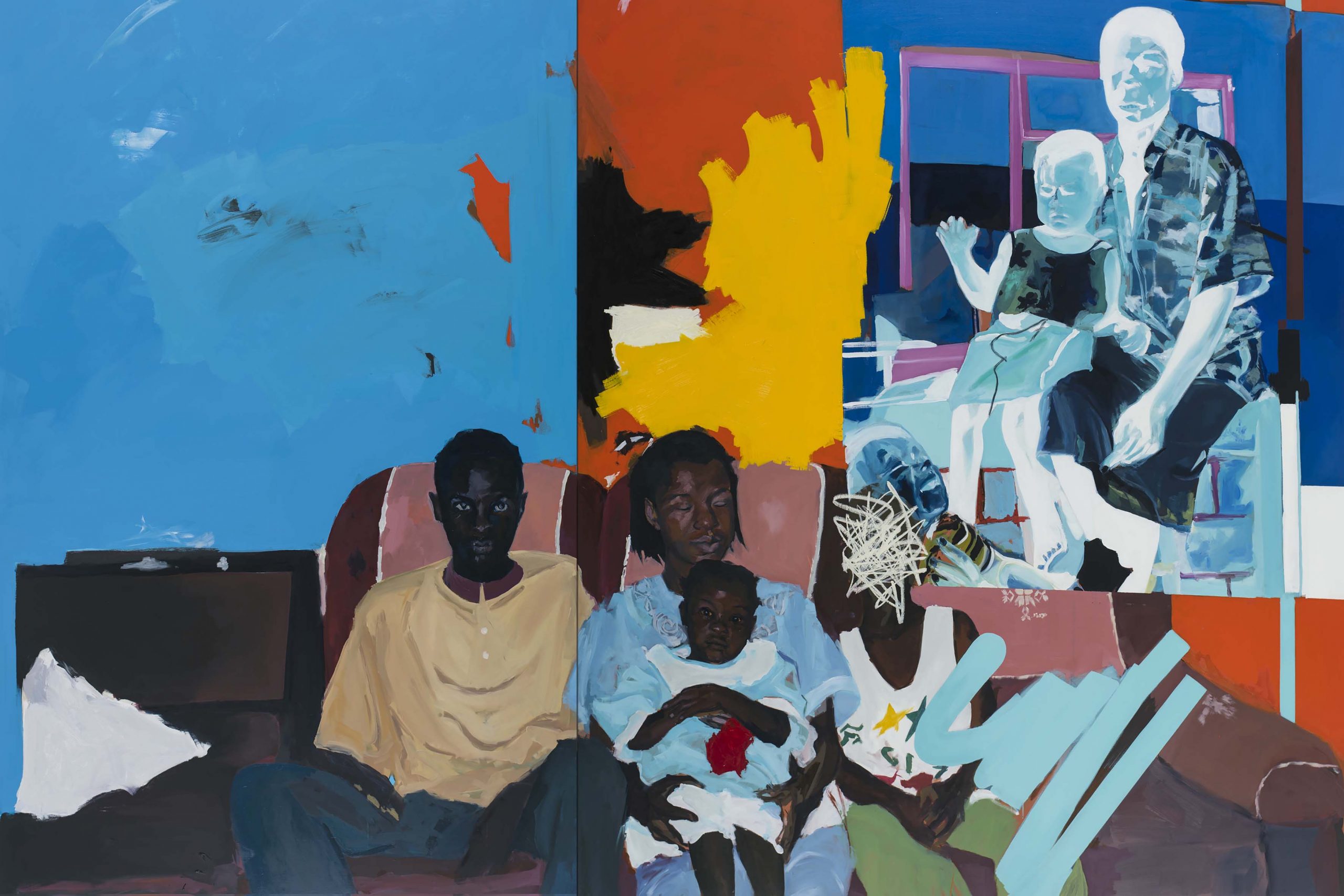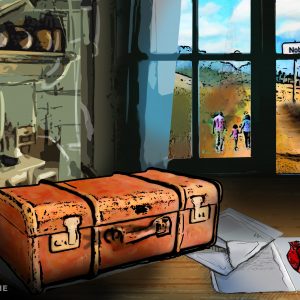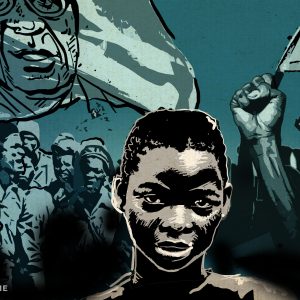Nostalgia, undone: remembering Zimbabwe’s past
The painter Kudzanai-Violet Hwami has an interpretive ability to take apart old stories and refashion them in such a way that compelling new narratives are born.
Author:
29 May 2020

Zimbabwe – said to be named by the nationalist Michael Mawema in 1960 – is the invention of a people burdened by nostalgia. The word nostalgia comes from the Greek roots nostos (homecoming) and algia (longing). It names the distance between what used to be and what currently is; it tugs toward a return to the past. “The irony of nostalgia,” the South African historian Jacob Dlamini tells us, “is that for all its fixation on the past, it is essentially about the present. It is about present anxieties refracted through the prism of the past.”
In calling this nation of their dreams Zimbabwe, what anxieties – if we can call them that; the word seems too light – were the black people living in Rhodesia working out through a nostalgic attachment to the past? The stakes were high: the colonial archive was innately compromised and those who dared narrate against its claims were co-opted, silenced or killed. Despite this, or because of it, artists still insisted on staking a claim to the past. Take Solomon Mutswairo’s Feso, the first Shona novel published by the Rhodesian Literature Bureau, in 1956. Living under colonial occupation in the 1950s, Mutswairo wrestled with what it meant to conceive a novel about an ancient Zezuru kingdom (the Zezuru are an ethnic group among the Shona who, today, occupy the area in and around Harare). The problem, as he saw it, was that “what is recalled to memory tends to be dimmed and faded with the passage of time and only a silver lining of truth remains to give us the events of the nostalgic past”. Given this failure of memory and the insufficiency of the archive, the novelist’s task was “to piece together the bits and pieces of this jigsaw puzzle”. And so Mutswairo wrote a story about an authoritarian king named Pfumojena (the pointedly named White Spear), who is ultimately conquered by the Vahota, an ethnic group linked to the revolutionary ancestral spirit Nehanda.
Related article:
Mutswairo was producing an account of a nation whose history predated colonial time, a history that was now tantalisingly at hand through the writer’s divination. This history, he was suggesting to readers attuned to the drumbeat of insurrection, could be grasped with both hands and wielded to revive a dormant nation. Mutswairo’s sly act of invention did not go unnoticed by the bureau, which excised a provocative first chapter, an allegory about land dispossession, from Feso. The chapter only returned to an English translation published in 1995, when Mutswairo’s imagination no longer exceeded the vision of the state that claimed and contained his body. The name of this new state, a simplification of Dzimbamabwe (house of stone), the 11th-century ruins found in the southern part of the country, insisted on the fact that there was black civilisation – no, black life – before colonial occupation. Mutswairo’s identification with the Zimbabwean nation he and others had imagined became complete when he gave it its song. In 1993, he penned the lyrics to the national anthem, Simudzai Mureza / Kalibusiswe Ilizwe leZimbabwe (O lift high, high, our Flag of Zimbabwe), which replaced Ishe Komborera Africa / Nkosi Sikelel’ iAfrica, the hymn composed by the South African teacher Enoch Sontonga.
A new generation’s quest
Forty years into independence, the children who grew up singing Mutswairo’s words are now making their own art that bristles against an oppressive state’s constraints. Many of these born-frees who are not yet free are also steeped in nostalgia, grasping at the fragments of recent history to reflect on the nationalist project. Born in 1993, Kudzanai-Violet Hwami is among the most thoughtful interpreters of Zimbabwe’s recent past. Hwami was born in Gutu, in the shadows of the Great Zimbabwe ruins. By the time she came into the world, the freedom dreams that had clung to the air after independence had started to dissipate, scattered by the violence of the Gukurahundi massacres between 1982 and 1987 (in which about 20 000 people of Ndebele ethnicity were killed by Robert Mugabe’s army), the fractious debates over Zanu-PF’s designs for a one-party state, and the imposition of economic structural adjustment. Hwami’s work is born out of the migration and displacement that followed Zimbabwe’s decline in the late 1990s. Like millions of other Zimbabweans, Hwami’s family first went to South Africa, where she lived between the ages of nine and 17. Currently a master of fine arts student at the Ruskin School of Art at Oxford University, she is now part of a cohort of Zimbabwean artists who have achieved international acclaim in recent years. In 2019, Hwami was among the artists featured in the Zimbabwe pavilion at the Venice Biennale.
Hwami’s second solo show, If You Keep Going South You’ll Meet Yourself, was exhibited at the Tyburn Gallery in London in 2017. A meditation on home, memory and identity, it was steeped in 1990s nostalgia, or “the time when things were still good” in contemporary Zimbabwean idiom. Like many of Zimbabwe’s storytellers, she has not escaped the seduction of the archive, mining it for its affective charge. If You Keep Going South began with Hwami digging through and reproducing images from her own family album. As a result, her paintings achieve a remarkable intimacy, relying on small details that wink at a distinctly Zimbabwean aesthetic: seat covers on the sofa, familiar bedspreads, mid-90s fashion from Power Sales. Look closely and you’ll see clothes that hang off the body in that distinct two-sizes-too-big Zimbabwean kind of way, people who carry themselves like members of your family or mine. There is palpable tenderness in these depictions, which Hwami attributes to “an element of trying to create a fictional family within the work, and I guess that has to do with being displaced and not having close family in proximity … I am creating fictional narratives around these images I archive and find.”
Related article:
Hwami’s artistic process is a deliberate, virtuosic playing with memory, making literal Mutswairo’s rearrangement of the puzzle pieces. But while Mutswairo’s project was to make the puzzle pieces cohere into a history that could inspire nationalist consciousness, Hwami, who insists that her work is informed by her multiple identities (black, lesbian, Zimbabwean and Shona), is not fashioning a master narrative. Instead she directs her gaze to the intimacy of family and the domestic, piecing together small moments immortalised by the photographic image to make something useful for managing the pain of being far from home. She has spoken about how she begins each painting by making a digital collage from these found photographs. Projecting this image on the canvas, she then meticulously reproduces the collage by hand. It is a lengthy process, but she explains that it is “the labor that goes into making a piece that’s intriguing to me”. Although the final effect might convey a certain freedom, it is “not a spontaneous thing, it’s all planned”.
Layered families
One particular Hwami painting keeps surfacing in my mind; I was filled with so much pain and longing when I first saw it as I scrolled online somewhere. Four people sit on a brown sofa, facing the viewer. The eye recognises something that looks like a photograph, and the title tells us that this is a family portrait. But it is a bit of misdirection, a playing with form by a skillful painter. The bright blue wall behind the family turns into streaks of red, black and yellow, as if an unsupervised child who is about to be in Big Trouble has discovered and scribbled all over the family album. A superimposed image in the upper right corner, a woman and a child who are posing for a different camera, is rendered in stark whites and dark and moody blues.
It turns out that this is a reproduction of another painting that appears in the show, titled Sisi neMwana. The version of Sisi neMwana that Hwami embeds in Family Portrait looks like a photo negative of the original full-size painting. The subjects in these two separate photos – who together constitute a “family” – are layered upon each other as pictures in an album might be as they come unstuck and move around in that thin layer between crinkly plastic and construction paper. Photographs that have been reproduced as paintings “rub against” each other, as Keguro Macharia might put it. Out of this encounter comes an image of the Zimbabwean family that we don’t always get to see. While domestic workers are typically secreted away in the spare bedroom when they are not conducting their duties, hardly treated as part of the family unit even as they are absolutely indispensable to it, in Family Portrait Sisi is literally in the picture.
The photograph opens up Hwami’s exploration of the pain of migration, what it means to hold on to a place even as the gulf between you and it widens with each passing year. Notice that the small child’s face, which overlaps with the photo negative, has been scribbled out in white, introducing a tension to the painting. There is nothing easy about remembering the past. In a Hwami painting, we see what the Ndebele writer Sané Dube, recalling her own family’s migration to Canada, called “the fragmented selves we carried in our chests”. (Sitting with my own fear of succumbing to a virus that will attack my lungs when I am far from home, I reread Dube’s phrase and I imagine this fragmented self’s heavy, laboured breathing).
Defying the daddy nationalists
Hwami’s exploration of what the photograph can incite us to remember is preceded by a longer national engagement with this question. In fact, I would argue that one of the founding documents of the Zimbabwean nation-state, one of the objects through which nationalists politicised their nostalgia, is a photograph. Close your eyes and imagine her: a young woman named Charwe wokwa Hota in the center of a black and white image, flanked by her co-conspirators, facing down the camera. Taken in 1897, this photograph documented the capture of the medium of the ancestral spirit Nehanda, said to have led one of the insurrections against the British South Africa Company. The photograph was supposed to enact its own violence, to later be looked upon as evidence that they had finally caught and murdered her. But like the ancestral spirit herself, it had an agency beyond the designs of the people who captured her and it. When the nation’s stirrings took a violent jolt once more in the 1960s, nationalists spun a new story from the photograph. Artists sympathetic to the cause reproduced the 1897 photograph on pamphlets and posters, making true her prediction that her bones would rise again. Nehanda no longer represented surrender but defiance.
What a shame, a failure of imagination, that this nation said to be born of a woman has had its history so thoroughly masculinised. It has taken artists who can be irreverent and playful about history to show us a path that diverges from the stories that have been narrated by the daddy nationalists. In 1994, just a year after Hwami’s birth, the novelist Yvonne Vera, then another young Zimbabwean artist living in the diaspora, made a dazzling appearance at the Harare Book Fair. At the time, Vera was completing a PhD in literature at York University in Canada and was interested in many of the themes that occupy Hwami today. “I explore my imagination, I explore my memory of home, I am steadfastly trying to identify who I am,” she explained. Having recently reimagined the nationalist foremother in the novel Nehanda, she was setting the stage for her intellectual project, telling a bemused interviewer who just couldn’t get a handle on this woman who had so many thoughts: “There is a need to mythologise history… It is forceful and liberating to use myth, which is nevertheless history.” How can the artist’s imagination infiltrate, commingle with and even supplant nationalist history? We now know where Vera’s imagination took her, to places inhabited by wildly self-possessed women, places made and remade by the daily improvisations and swaying rhythms of black life. Revealing the breadth of her interest in what the imagination could do for the nation, upon her return to Zimbabwe, she also became the director of the Bulawayo branch of the National Gallery of Zimbabwe.
The utopia dream
Hwami uses myth to propel herself and the nation into the future: “In my paintings, I like to create a positive future … like a utopia dream. So, I paint the future of Zimbabwe in a light manner instead of painting what goes on now, because that doesn’t help me heal.” There is a melancholy behind that; how could there not be? But there is also a playfulness to it. We remember that the dancehall singer Killer T commands us, “hatingapedze album rese tichichema (we can’t spend the whole album crying).” We see glimpses of Hwami’s “utopia dream” – the Zimbabwe she wants – in her other work, studies of the black body in repose. In one painting, a man with an Afro wearing blue briefs and black sunglasses languidly stretches out on a canoe perched on the beach. Propped up on his forearms, he faces the viewer, the right leg folded over the left, the left stretched out long. He poses like he knows he is beautiful. All around him is blue water and craggy rocks. A sign in the background to the left of his head reads “Beitbridge Sea Front”, a little joke about our famously landlocked country. The border separating Zimbabwe and South Africa, a site of routine violence, is reimagined as a beachfront, a site of relaxation, a setting for the queer erotic. His yellow canoe reads “Queer Zim Freedom Boat”. Where is this beautiful queer man going? Is he escaping Mugabeism like millions before him? Doesn’t he realise that it’s too dangerous, too impractical to try to make it across this not-real sea in that tiny little canoe? What is the freedom boat’s final destination? The title of the painting gives us a firm answer: Ain’t Leaving this Country.
Living with longing
Hwami warned me that if I kept going, I’d meet myself. I should have stopped writing here. I lived with a suffocating feeling of dread while I wrote this essay. Acting independently of my desires, it had a sadist’s manner of alerting me of my bruises by pressing down on them until I could no longer deny that they were there and that they hurt. Like Hwami, I am a diasporan. I left Zimbabwe for America in 2000, as the spectacular dissolution of my parents’ marriage coincided with the creeping collapse of the Zimbabwean economy. Family networks were hastily activated so that my mother, sister and I could join my aunt in America.
One evening, I finally gave in to what this writing was demanding and retrieved my plastic bag of photos, tucked away on the top shelf of my closet, secured in place between two large suitcases that have taken me everywhere since I was 16. Over the years, I have pilfered images of myself and my family from relatives, trying to suture an archive of my past life in Zimbabwe, a life before the rupture of migration. There I am on my sixth birthday, beaming for my father’s camera (a small black one that let out a little quiet whistle after the flash) on an armchair in my parents’ bedroom. A snapshot of early 1990s Zimbabwean kitsch, it evokes a Hwami painting: a pink and green floral motif creeps from the curtains to the armchair and the bedspread. The motif terminates on my shin in the form of a small floral patch on a pink tracksuit, a birthday present. My face gleams under a thick layer of Vaseline. I imagine hands gripping my shoulders as I squirm, a voice warning me that I cannot leave the house ndine shena (looking ashy).
More fragments return: the brown carpet in the room, the unyielding, squeaky springs in the seat of the armchair, ointment slathered on my back in the adjoining pink-tiled bathroom when I got chickenpox. The din of voices yelling, bodies shoving, someone leaving for good; my mother praying and speaking in tongues for weeks afterwards. Me, uncertain and afraid, quietly asking her not to do it anymore. The last time I saw that room, the day we left to come to America, all the furniture was gone. Only a few objects remained, scattered on the brown carpet: stray clothes, shoes and hangers. When I look at this photograph of “when things were still good”, I wonder how Hwami’s eye would take this image apart and put it back together again – how she would, in the process, alert me of the impossibility of retrieving whole the thing I am grasping for.
A reshuffle of fragments
It seems that living with this type of longing is the nation’s lot. For a while now, Zimbabwean public discourse has been beset by a desire to reset our national clock back to some day in our recent past, to revert to a sense of normal fashioned largely from the remembrances of the middle class. How comforting when conversations dip into memories of buses that ran on time and milk deliveries at our doors, how animated we get when the reminders of old times – music video clips featuring bad 1990s fashion, geometric haircuts and technicolor backgrounds – come through WhatsApp and briefly suspend our lives of displacement and disconnection. (In this regard, we are not alone on the continent. Take the Nostalgia Projects from various African countries – photo archives of the recent past – that populate Facebook, eliciting remembrances of times when “things were still good” for Africans scattered across the diaspora.)
It is a fruitless exercise to write against nostalgia, especially in this moment of profound alienation, when holding on to memories of “the way things were” might be the only thing keeping many people alive. I’m not trying to be that clever. But I’m always afraid that these images can trap us if we allow them to become too still and too complete, reifying an ideal vision of Zimbabwe that was already exclusionary and violent, a nation that had energetically taken up the colonial fixation with marking and casting out enemies. What might it mean to take my images of the middle-class strivings of a young Shona family in Harare and slot them in the album next to the kinds of images that the writer Melusi Nkomo offers from his own childhood: a congested house full of relatives fleeing violence during the Gukurahundi, the army terrorising villages in Matabeleland long before it officially took power in 2017? There is no uniform, comforting narrative of what “we” once were that can come out of this.
Related article:
Hwami’s refusal of coherence, along with her insistence on looking tenderly at the queer, the feminine – at blackness itself – is what makes her art well suited for the challenge of reimagining Zimbabwe at this juncture in its history, when it is still ruled by a party that has done little to move us away from the violent logics of colonialism. It is not an easy feat to maintain a productive unease with your nostalgia, dipping into its pleasures while never allowing it to lull you into too much forgetfulness. That is why Hwami’s paintings demand that you keep thinking with them. The slow, deliberate labour involved in unfaithfully translating the photograph to the canvas, the time spent “messing up” the photograph with scribbles, overlaps and negatives is a reminder that whatever Zimbabwe is, it is necessarily fictive, a product of our collective fashioning. A Hwami painting asks: of what use are the myths around which we organise our identities, our families, our nation? How do we live – sometimes painfully – with the many stories we tell about ourselves? What is your utopia dream?
If you keep looking, Hwami’s work extends an invitation to make anew. She doesn’t abandon the past but takes apart old stories – with intention, longing and care – and then she puts them together again in a way that transforms what and how we see.
We can do the same.



